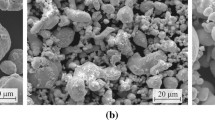Abstract
In this study, commercially pure Ti powder was consolidated by the electrical resistance sintering (ERS) technique. This consolidation technique consists of the application of pressure (around 100 MPa) to a powder mass at the same time that the powder is heated by the passage of an electric current of high intensity (around 10 kA), low voltage (around 5 V) and a frequency of 50 Hz. Several current intensities and dwell times were tested during the consolidation process. The work includes a microstructural study of the most relevant characteristics of the compacts. Furthermore, the obtained compacts were mechanically characterised by the measurement of their hardness distribution and by an indirect tensile test. For all the compacts, the average hardness and the strength resulting from the indirect tensile test are empirically related to the global porosity of the compact and the electric energy supplied during the consolidation process. This energy is a function of the intensity of the electric current and the dwell time. These empirical relationships can be useful to select the best process conditions. The results were compared with values obtained for specimens prepared with the same powder by the conventional powder-metallurgy route of cold die pressing and furnace sintering.















Similar content being viewed by others
References
Taylor GF (1933) Apparatus for making hard metal compositions. US Patent 1896854, Feb 1933
Lenel FV (1955) J Met 7:158
Suzuki T, Saito S (1971) J Jpn Soc Powder Powder Metall 18:28
Saito S, Ishitama T, Sawaoka A (1974) Bull Tokyo Inst Technol 120:137
Hara Z, Akechi K (1980) In: Kimura H, Izumi O (eds) Titanium ’80. Science and technology, proceedings of the 4th international conference on Ti, Kyoto, Japan, 19–22 May 1980. The Metallurgical Society of AIME, New York, p 2265
Okazaki K (1994) Rev Part Mater 2:215
Istomina TI, Baidenko AA, Raichenko AI, Golberg MA, Svechkov AV (1983) Sov Powder Metall Met Ceram 22(11):957
Burenkov GL, Raichenko AI, Suraeva M (1987) Sov Powder Metall Met Ceram 26(9):709
Sukhov OV, Baidenko AA, Istomina TI, Raichenko AI, Popov VP, Svechkov AV, Golberg MA (1987) Sov Powder Metall Met Ceram 26(7):530
Yokota M, Nagae T, Nose M (1998) Proceedings of the world congress PM’98, Granada, Spain, 18–22 Oct 1998. EPMA, Bellstone, Shrewsbury, p 284
Moriguchi H, Tsuduki K, Ikegaya A (2000) Powder Metall 43(1):17
Groza JR, Zavaliangos A (2000) Mater Sci Eng A 287:171
Montes JM, Rodríguez JA, Herrera EJ (2003) Rev Met Madrid 39:99 (in Spanish)
Montes JM, Cintas J, Cuevas FG, Rodríguez JA (2004) Proceedings of Euro PM 2004, Vienna, Austria, 17–21 Oct 2004, vol 2. EPMA, Bellstone, Shrewsbury p 259
Henriques VAR, Galvani ET, Petroni SLG, Paula MSM, Lemos TG (2010) J Mater Sci 45(21):5844. doi:https://doi.org/10.1007/s10853-010-4660-8
Mao ZP, Ma J, Wang J, Sun B (2009) J Mater Sci 44(12):3265. doi:https://doi.org/10.1007/s10853-009-3438-3
Tuncer N, Arslan G (2009) J Mater Sci 44(6):1477. doi:https://doi.org/10.1007/s10853-008-3167-z
Li H, Yuan B, Gao Y, Chung CY, Zhu M (2009) J Mater Sci 44(3):875. doi:https://doi.org/10.1007/s10853-008-3193-x
ASTM B 265-06a (2006) Standard specification for titanium and titanium alloy strip, sheet and plate. ASTM International, West Conshohocken, PA, USA
ASM Handbook (1998) Metal powder technologies and applications, vol 7. ASM International, USA
Capua JR, Michot G (2006) Int J Fract 139:455
Montes JM, Cuevas FG, Cintas J (2007) Metall Mater Trans B 38:957
Acknowledgements
The authors are grateful to FEDER/MCyT, Madrid, and Junta de Andalucía for funding this research within the framework of the Projects MAT2007-61643 and P08-TEP-3537, respectively. The authors also wish to thank the technicians J. Pinto, M. Madrid and M. Sánchez (Univ. Seville, Spain) for experimental assistance.
Author information
Authors and Affiliations
Corresponding author
Rights and permissions
About this article
Cite this article
Montes, J.M., Rodríguez, J.A., Cuevas, F.G. et al. Consolidation by electrical resistance sintering of Ti powder. J Mater Sci 46, 5197–5207 (2011). https://doi.org/10.1007/s10853-011-5456-1
Received:
Accepted:
Published:
Issue Date:
DOI: https://doi.org/10.1007/s10853-011-5456-1




